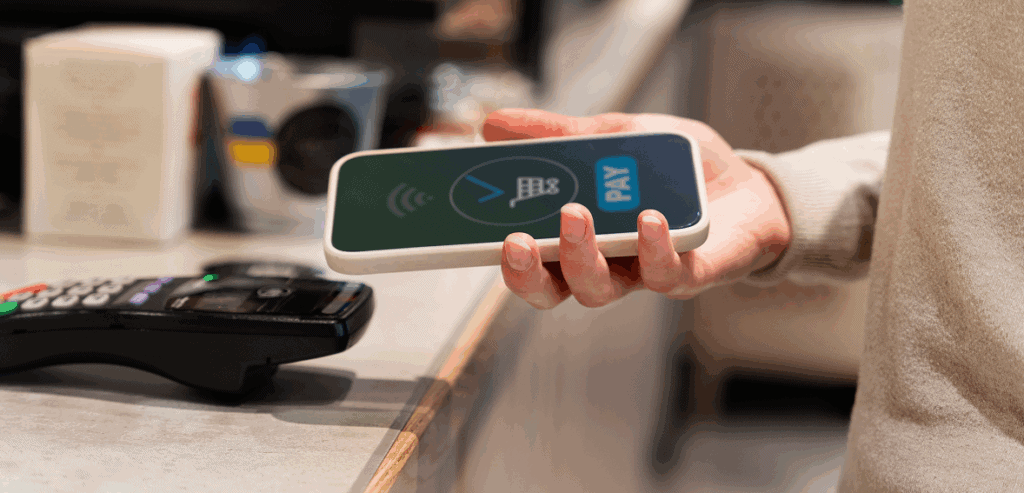
By Ella Rees May 8, 2025
Retail is evolving quickly in response to changes in technology, consumer behavior, and security needs. As customers increasingly expect faster, safer, and more flexible ways to pay, retailers must keep up with these expectations by adopting the right payment technologies. EMV, NFC, and mobile wallet payments are three modern solutions that have become critical to staying competitive. Each offers unique advantages in terms of security, convenience, and customer satisfaction.
For retailers unfamiliar with the differences between these technologies, or unsure how they fit into their current operations, this guide provides a clear explanation. Understanding how EMV chip cards, NFC contactless technology, and mobile wallets work can help businesses upgrade their payment infrastructure, reduce fraud, and improve the checkout experience.
What Is EMV and Why It Matters

EMV stands for Europay, Mastercard, and Visa. It refers to the global standard for smart payment cards that use chip technology instead of magnetic stripes. EMV cards contain embedded microprocessors that encrypt transaction data during the payment process. This technology helps prevent card cloning and significantly reduces in-person credit card fraud.
Unlike the traditional magnetic stripe, which stores static data, the EMV chip generates a unique code for each transaction. This code cannot be reused, making it far more difficult for criminals to duplicate or intercept card information. EMV cards can be inserted into payment terminals or tapped if they are contactless enabled.
Retailers who accept chip cards are better protected against liability for fraudulent transactions. In many regions, including the United States, a liability shift took place in 2015. This means that if a retailer does not support EMV transactions and fraud occurs, the merchant may be held responsible instead of the card issuer.
Adopting EMV-compliant terminals is a basic but important step toward modernizing retail payment systems and protecting against losses.
Understanding NFC and Contactless Payments
NFC stands for Near Field Communication. It is the wireless technology that enables two devices to communicate when they are close together. In the context of retail payments, NFC allows customers to tap their contactless card or smartphone near a terminal to complete a transaction.
NFC works by transmitting encrypted payment data over a very short distance, typically less than two inches. This not only makes transactions fast but also secure. Because NFC does not require physical contact, it reduces wear and tear on terminals and provides a more hygienic option for customers.
For retailers, offering NFC payment options means embracing a frictionless checkout experience. Customers are increasingly seeking contactless options, especially following heightened awareness around hygiene and safety. Retailers that offer tap-to-pay capabilities show that they are forward-thinking and customer-focused.
NFC is not limited to bank cards. It is also the technology that powers mobile wallets like Apple Pay, Google Pay, and Samsung Pay, making it a key component of the broader mobile payment ecosystem.
The Rise of Mobile Wallets
Mobile wallets are digital applications that store a customer’s payment card information securely on a smartphone or wearable device. These wallets allow users to pay by holding their device near an NFC-enabled terminal and authenticating the transaction with a fingerprint, face recognition, or passcode.
Popular mobile wallets include Apple Pay, Google Pay, and Samsung Pay. Each of these platforms uses advanced security protocols like tokenization, which replaces sensitive card data with a unique identifier that is useless to hackers. The actual card number is never transmitted during a mobile wallet transaction.
For consumers, mobile wallets offer a fast, convenient, and secure way to pay. They also allow users to store loyalty cards, coupons, and transit passes, making them a one-stop solution for many daily needs. For retailers, accepting mobile wallets can help attract tech-savvy customers, reduce checkout times, and improve transaction security.
Mobile wallet adoption continues to grow. Retailers who integrate support for these platforms position themselves to meet current demand and prepare for future shifts in consumer behavior.
EMV, NFC, and Mobile Wallets Compared
While EMV, NFC, and mobile wallets all contribute to a modern payment experience, they are not the same. Each plays a distinct role in the checkout process.
EMV refers to the chip-based card standard that enhances transaction security. It requires customers to insert their card into a reader or tap it if contactless. EMV is now the baseline for secure card-present payments.
NFC is the technology that allows for contactless communication between devices. It is used in both contactless cards and mobile wallets. NFC enables fast, touch-free transactions that customers increasingly prefer.
Mobile wallets are apps that store card data on a smartphone or watch. They use NFC to process payments and offer extra features like biometric authentication, loyalty integration, and digital receipts.
Retailers do not have to choose one over the others. The best approach is to adopt payment systems that support all three, allowing customers to pay using the method they prefer.
Benefits for Retailers
There are many reasons why retailers should embrace EMV, NFC, and mobile wallet payments. One of the most important is security. EMV and mobile wallets offer advanced fraud prevention through encryption and tokenization. This reduces the risk of chargebacks and protects customer trust.
Speed is another advantage. Contactless payments and mobile wallets complete transactions faster than traditional chip or swipe methods. This leads to shorter lines, higher throughput, and a smoother shopping experience.
Customer satisfaction also improves. Shoppers appreciate having options. Whether they prefer using their phone, their card, or their wearable device, giving them a choice builds loyalty and shows that the retailer values convenience.
From a business operations perspective, modern payment solutions are often easier to manage. They integrate with digital reporting tools, offer real-time analytics, and reduce the need for physical cash handling.
Finally, staying current with payment technology helps future-proof your business. As digital wallets and contactless cards become more common, retailers that have already made the switch will be ahead of the curve.
Choosing the Right Payment Terminal
To accept EMV, NFC, and mobile wallet payments, retailers need the right hardware. Modern point-of-sale terminals support chip readers, tap-to-pay functionality, and digital wallet compatibility. When choosing a terminal, look for models that are certified by major card networks and support multiple payment formats.
It is also important to ensure that the terminal integrates smoothly with your existing software and accounting systems. Some payment processors offer bundled solutions that include hardware, software, and reporting tools. These packages can simplify setup and support.
Consider the layout of your checkout area. Terminals should be positioned for easy access and clear communication. Customers should feel comfortable and confident when using contactless or digital payment methods.
Training staff is also crucial. Make sure employees understand how to guide customers through the process, troubleshoot issues, and respond to questions about payment security.
Preparing for the Shift in Consumer Expectations
Customers are becoming more accustomed to digital and contactless experiences in every aspect of life. From ride-sharing to food delivery, the convenience of mobile-first interactions has shaped expectations for retail as well.
In this context, payment flexibility is part of customer service. Offering EMV, NFC, and mobile wallet options signals that your business is keeping pace with the times. It tells customers that their convenience and security matter to you.
Promote your payment options through in-store signage, online listings, and customer communication. Let people know they can use their preferred methods, and show that you welcome innovation.
Stay informed about emerging trends. As mobile wallets evolve to include more features like buy now pay later options, loyalty integrations, and in-app shopping, retailers should be ready to adapt. A flexible payment system lays the groundwork for these future enhancements.
Addressing Concerns and Misconceptions

Some retailers are hesitant to adopt new payment technologies due to concerns about cost, complexity, or reliability. While these concerns are understandable, most modern payment systems are affordable and user-friendly.
The cost of upgrading hardware is often outweighed by the benefits in speed, security, and customer satisfaction. Many providers offer leasing options or bundled deals to make the transition more accessible.
Complexity is another perceived barrier. However, most systems are designed to be intuitive and come with support services to assist with installation and training. With proper setup, day-to-day use becomes seamless.
Reliability is critical. Retailers worry about systems going down or transactions failing. Choose a reputable provider with a strong track record and robust support. Backup connectivity and redundant systems can ensure that payments continue even during internet outages.
Conclusion
In today’s retail environment, accepting a variety of secure, fast, and customer-friendly payment methods is not just a nice feature. It is a necessity. EMV, NFC, and mobile wallet payments each bring unique strengths to the checkout experience. Together, they form the backbone of a modern, flexible, and forward-looking retail operation.
For retailers, adopting these technologies means staying competitive, building customer loyalty, and reducing the risks associated with outdated systems. As more consumers embrace contactless and mobile payments, the businesses that meet them where they are will stand out in both service and security.
The investment in better payment systems is more than a technical upgrade. It is a commitment to customer trust, operational efficiency, and long-term growth.